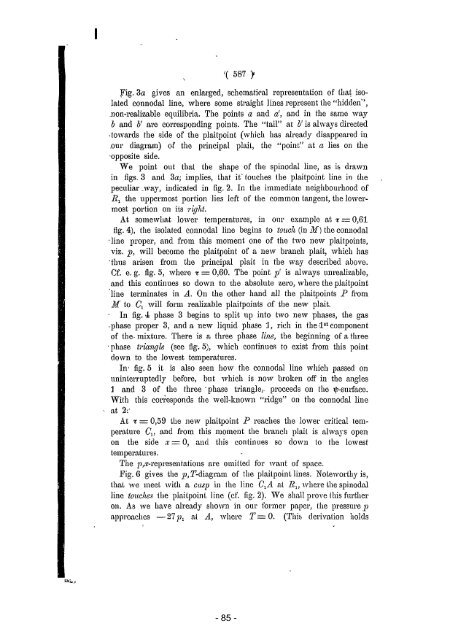Proceedings of the section of sciences - DWC - KNAW
Proceedings of the section of sciences - DWC - KNAW
Proceedings of the section of sciences - DWC - KNAW
You also want an ePaper? Increase the reach of your titles
YUMPU automatically turns print PDFs into web optimized ePapers that Google loves.
I( 587 )<br />
;Fig. 3a gives an enlal'ged, schematiral repl'eselltation <strong>of</strong> tllat isolated<br />
cOllnodal line, where some straight lines represent ihe "hidden",<br />
.non-realizable equilibria. The points a and a', and in <strong>the</strong> same way<br />
band b' are corresponding points. The "tail" ar b' is ahvays directed<br />
,towards <strong>the</strong> side <strong>of</strong> <strong>the</strong> plaitpoint (which has al ready disappeared in<br />
.our diagram) <strong>of</strong> <strong>the</strong> principal plaiL, <strong>the</strong> "point" at a lies on <strong>the</strong><br />
'opposite side.<br />
We point out thai <strong>the</strong> shape <strong>of</strong> <strong>the</strong> spinodal line, as i& drawn<br />
in figs. 3 and 3a; impJies, that if touches <strong>the</strong> plaitpoint line in <strong>the</strong><br />
peculiar _ way, indicated in fig', 2. In <strong>the</strong> immediate neighbourhood <strong>of</strong><br />
Rl <strong>the</strong> uppermost portion lies left <strong>of</strong> <strong>the</strong> common tangent, <strong>the</strong> lowermost<br />
portion on its 1'ight.<br />
At somewhat lowel' temperatures, in om example at T = 0,61<br />
fig. 4), <strong>the</strong> isolated connodal line begins to touch (in Af) <strong>the</strong> connodal<br />
'line proper, and from this moment one <strong>of</strong> <strong>the</strong> two new plaitpoints,<br />
viz. p, will become <strong>the</strong> plaitpoint <strong>of</strong> a new branch plait, which has<br />
'thus arisen from <strong>the</strong> pl'incipal plait in <strong>the</strong> way described above.<br />
Cf. e. g. fig. 5, where T = 0,60. The point p' is always unrealizable,<br />
and this continues so down to <strong>the</strong> absolute zero, where <strong>the</strong> plaitpoint<br />
'line tel'minates in A. On <strong>the</strong> o<strong>the</strong>r hand all <strong>the</strong> plaitpoints P fi'om<br />
M to Cl will form realizable plaitpoints <strong>of</strong> <strong>the</strong> new plait.<br />
In fig. '* ph ase 3 begins to split up into two new phases, <strong>the</strong> gas<br />
,phase proper 3, and a new liquid phase j, rich in <strong>the</strong> 11 st component<br />
<strong>of</strong> <strong>the</strong>· mixture. The1'e is a th1'ee phase line, <strong>the</strong> beginning <strong>of</strong> a th1'ee<br />
'phase triangle (see fig. 5), which continue::; to exist from this point<br />
down to <strong>the</strong> lowest temperatures.<br />
In' fig. 5 it is also seen how <strong>the</strong> connodal line which passed on<br />
uninterruptedly before, but which is now brokE'll <strong>of</strong>f in <strong>the</strong> angles<br />
1 and 3 <strong>of</strong> <strong>the</strong> th ree -phase triangle" proceeds on <strong>the</strong> ll,-surface.<br />
With this corresponds <strong>the</strong> well-Imown "ridge" on <strong>the</strong> connodal line<br />
, at 2:'<br />
At T = 0,59 <strong>the</strong> new plaitpoint P reaches <strong>the</strong> lower critical temperature<br />
Cl' and from this moment <strong>the</strong> branch plait is always open<br />
on <strong>the</strong> side :1: = 0, and this continues so down to <strong>the</strong> lowest<br />
tem peratures.<br />
The p,.'lJ-repl·esentations are omitLeci for want <strong>of</strong> space,<br />
Fig. 6 gives <strong>the</strong> p,T-diagram <strong>of</strong> <strong>the</strong> plaiipoint lines. Noteworthy is,<br />
thaL we meeL with a CllSp in <strong>the</strong> lino elA at Ru wh ere <strong>the</strong> spinodal<br />
line touches <strong>the</strong> plaiLpoinL line (cf. fig. 2). We shaH prove this fm'<strong>the</strong>r<br />
on. As we have already SI10W11 in our formel' paper, <strong>the</strong> pressUl'e p<br />
appl'oaches - 27]h at A, ·where T = 0. (Thi& derivaiion holds<br />
- 85 -

















